#kurt weston photography
Explore tagged Tumblr posts
Text
#photographs#photography#photography blog#Kurt Weston photography#iconic images#Kurt Weston in his own words#Photographer Kurt Weston#award-winning photographer#legally-blind photographer#black-and-white photography#Photographer interview
1 note
·
View note
Photo

Title: Robert Mapplethorpe He was one of most gracious and giving people I have ever worked with. As usual I set up the camera on the tripod, determined the part of his environment that would help define him and set the exposure. We worked for about 10 minutes and I was done. Robert then asked if I would be interested in seeing what he was working on at the time (1982). We then spent several hours looking at over 100 work prints of Lisa Lyons, the champion body builder he was working on for a book later titled “Lady”. Artist: Kurt Edward Fishback Date of image: 1982 Size: 15x17 inches (38x43 cm) Format: archival pigment Features: signed on front Price: $900
[x]
#Robert Mapplethorpe#1982#Kurt Edward Fishback#photography#Edward Weston#photographer#Duncan Miller Gallery
1 note
·
View note
Video
youtube
Gilette - “We Believe: The Best Men Can Be”
Agency: Grey
Campaign: “We Believe”
Worldwide Chief Creative Officer: John Patroulis
Deputy Chief Creative Officer: Jeff Stamp
Executive Creative Director: Joe Mongognia
Group Creative Director: Asan Aslam
Creative Director: Patrick Conlon
Planning Director: Kristian Henschel
EVP, Global Account Director: Brian Weston
SVP, Global Account Director: Marie Massat
VP, Global Account Director: Robert Chedid
Account Supervisor: Julie Ressler
Account Executive: Lindsay Auerbach
Project Manager: Joey Scarillo
Executive Production: Townhouse
VP, Executive Producer: Katy Hill
VP, Integrated Producer: Rondell Wescott
Music Producer: Kurt Steinke
Casting Supervision: Nina Pratt
Talent Manager: Alice Lambrides
Business Manager: Suzanne Voss
Production Company (location): somesuch
Director: Kim Gherig
Director of Photography: Adam Arkapaw
Executive Producer: Nicky Barnes
Line Producer: Saul Germaine
Editorial: Cosmo Street
Editors: Joshua Berger + Tom Lindsay
Head of Production: Anne Lai
Executive Producer: Maura Woodward
VFX, Picture Finishing, and Telecine: Moving Picture Company (MPC)
VFX Supervisor: Thiago Porto
Colorist: Mark Gethin
Creative Director: Alvin Cruz
Flame Artists: Joey Deady + John Shafto
2D Lead: Rob Ufer
Executive Producer: Matthew Loranger
Color Executive Producer: Meghan Lang
VFX Producer: Aiste Akelaityte
Color Producer: Rebecca Boorsma
Sound Design: Heard City
Sound Engineer: Keith Reynaud
Asst Sound Engineer: Tom Morris
Executive Producer: Gloria Pitagorsky
Music: Future Perfect Music
Composer/Artist: John Connolly, Adam Hochstatter, Ben Pacheco
Arranger: Victor Magro
Song title: “Reach Out”
Executive Producer: Maxwell Gosling
21 notes
·
View notes
Text






Photographs taken by Kurt Weston. Kurt Weston entered the field of contemporary visual art after extensive art education combined with fifteen years of work experience as a fashion photographer. In 1991 he was diagnosed with AIDS and just 5 years later became legally blind due to a related condition, cytomegalovirus retinitis. His series of self portraits represent the physical, psychological and emotional weight of sight loss. Weston is totally blind in his left eye and limited peripheral vision, no central vision in his right eye.
Kurt Weston’s artwork reminds me a lot of expressionism in how he is capturing his emotions through photography in a obscured way.
0 notes
Text
Out in the World: Still Life Photography between Art and Commerce
The intertwining of art and commercial photography is nowhere more evident than in the genre of still life
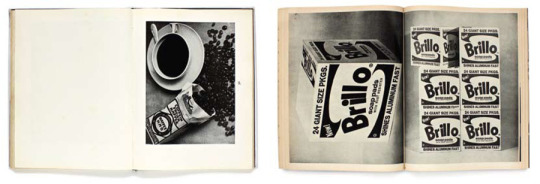
Albert Renger-Patzsch, advertisement for Kaffee Hag, from Die Welt ist schön (The World is Beautiful) Kurt Wolff, Munich, 1928 / Andy Warhol ‘Brillo Boxes’ 1964 From Andy Warhol Moderna Museet, Stockholm, 1968
Photography may have triumphed in art over the last couple of decades, but questions linger as to whether art gets the best out of it. Many artistically minded photographers admit to finding art an interesting place to visit but they wouldn’t want to live there. It can be airless, self-serving and very slow. (Photography permits rapid artistic development for those who want it, but curators and collectors rarely do.) Moreover, given that art photography triumphed by remaking, diverting or otherwise contemplating the medium’s ‘applied’ forms – such as the document, the film still, the advertisement and the archival image – there is always much in common between art photographs and those we see elsewhere.
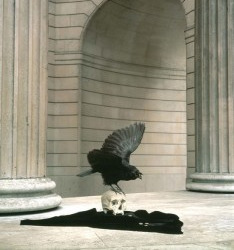
Karen Knorr The Principles of Political Economy 1990. Colour Cibachrome 114×91 cm From the series ‘Capital’
Nothing demonstrates this better than the promiscuous still life photograph, present everywhere from the gallery wall and the family album to billboards and mail-order catalogues. Picked fruit and cut flowers, artefacts of glass, plastic, wood and metal, objects rare and commonplace, the still life bridges art and commerce. Its rise from the lowest genre to the equal of landscape and portraiture followed the rise of commodity culture. In the 1820s and ’30s, the pioneers of photography could not resist gathering objects before their cameras. Nicéphore Niépce shot a dining table laid for one. Louis Daguerre contrived arrangements of classical sculpture and paintings. William Henry Fox Talbot showed off his china and glassware. Were these images documents, pictures for contemplation or advertising? All three. The still life was ideal for a world of accelerated manufacture and exchange, mobilizing desires and expressing tastes. Even the humble table, the basic support for the still life, was unthinkable without its marketable image. As Karl Marx famously declared in his 1867 passage on commodity fetishism, a table ‘not only stands with its feet on the ground, but in relation to all other commodities, it stands on its head, and evolves out of its wooden brain grotesque ideas, far more wonderful than if it were to begin dancing of its own free will.’1 Two years later, Comte de Lautréamont was after the new beauty of ‘the chance encounter, on an operating table, of a sewing machine and an umbrella’.2 Such wild tableaux! In the hallucination of capital the still life is a hybrid of sculpture and montage.
When photographers made their bid for modern artistic significance in the 1920s many were key figures in the medium’s applied fields, notably reportage, portraiture and the advertising still life. They included Man Ray, Edward Steichen, Laure Albin-Guillot, Helmar Lerski and Albert Renger-Patzsch. Others made still lifes that could be taken for advertisements (Edward Weston, László Moholy-Nagy, André Kertész, Heinz Hajek-Halke). But as Modernists true to their métier, the aim was to make good photographs and the ‘art’ part could be left to take care of itself. Photographers as different as Man Ray and Walker Evans insisted their medium was not art but it could be an art – a distinction lost on many today. Exhibiting or publishing a book of one’s commissioned work might be enough to shift the emphasis from the things depicted to the depiction, from anonymity to named author, from paid work to Works, from applied art to fine art. Context, as any photographer will tell you, is key.
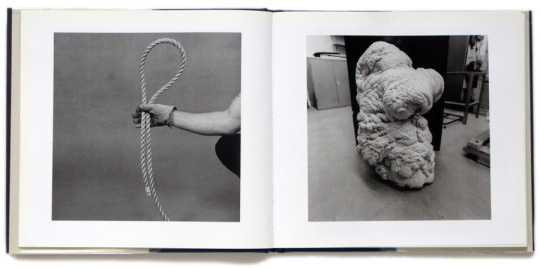
Mike Mandel & Larry Sultan, Evidence, 1977 Clatworthy Colorvues, 1977
This indirect path to artistic status produced extraordinary images – and they could only have been made that way. A weak claim to art can be a great stimulus for photography, but a strong claim can crush it. This is why so many contemporary photographers feel constrained by the anxious categories and stifling agendas of art world photography and look to the freedom of that older attitude. But this has proved difficult. In the 1950s and ’60s, commercial photography became wary of the unpredictability of art and tried to develop a reliable science of image design (the TV series Mad Men, 2007–ongoing, nails this shift brilliantly). Images would be vetted or even designed in the boardroom. In his 1964 essay ‘Rhetoric of the Image’, Roland Barthes examined a still life advertisement for Panzani, a food company contrived to connote ‘Italianicity’ to the French.3 It was the start of ‘photography theory’. Branded tins and packets intermingle with fresh fruit and vegetables spilling from a rustic net bag against a scarlet backdrop. It was a ruthlessly designed image and, like its makers, Barthes accounted for its every aspect from colour, lighting, composition and text to its committee authorship. He described the ideological sleight of hand that endows manufactured goods with ‘naturalness’. And it is photography that facilitates the slippage most effectively. It is unique in appearing to point at things transparently (‘there it is’) while fashioning appearance artificially (‘this is how it is’). Photographs are taken and made, natural and cultural. Barthes’s semiotic critique also aimed to be a science of popular signs and advertising got the analysis it deserved.
This calculated attitude was quite of a piece with Pop art’s approach to commodity images. Andy Warhol’s stacked ‘Brillo Boxes’ (1964) were a strategic fusion of the readymade and the still life, and it made little difference whether you saw them exhibited or in photographic reproduction: the flash of recognition was all. Warhol, the former ad man, grasped Marcel Duchamp’s insight that the industrial/commercial object plucked and placed incongruously (like Lautréamont’s monstrous encounter) will hit the viewer with the deadpan force of a snapshot. But a less remarked legacy of Pop was the polarizing of art’s attitudes to commerce into rictus-grin irony or high- minded disgust. It led to a fraught attitude to money, to the commodity status of art works themselves and, indirectly, to a stand- off between art photography and applied photography. Since the 1960s, the still life photograph in art has passed through the polemic Postmodern image–texts of Barbara Kruger (a former art director at Condé Nast), the post-classical allegories of Olivier Richon and Karen Knorr (whose first joint publication was a cookery book), and the photography-as-sculpture-montage-joke of Fischli/Weiss, Gabriel Orozco and Vik Muniz (a former advertiser). All of which is Art with a capital ‘A’, all of it keen to distance itself from the still life as Commerce (capital ‘C’), even though commerce is often the subject matter.
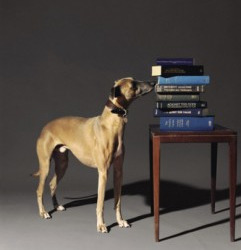
Olivier Richon, Studium, 2003
Consider two examples from either side of Pop, both by figures better known for other things. In 1955, Walker Evans published ‘Beauties of the Common Tool’ in Fortune magazine: five exquisitely restrained still lifes of one-dollar pliers and wrenches. Reproduced larger than life, they were monuments to blue-collar labour. In his accompanying text Evans praised them for holding out against overdesigned and image-led manufacture, while his photos resisted the graphic opulence typical of Fortune. In 1992, the BBC commissioned 20 artists to make public billboards, including the young Damien Hirst, who was the only one keen to do more than simply re-present gallery art. He approached a professional still life photographer to help shoot exquisitely restrained pairs of objects: a hammer with a peach and a cucumber with a pot of Vaseline. They formed two panels of a rotating tri-vision billboard; the third read ‘The Problems with Relationships’. On the street it looked like advertising with nothing to sell but an idea. Evans and Hirst were fashioning still life as a pitch-perfect intervention beyond art. However, whereas Hirst remade his billboard in 1996, exhibited it and sold it, Evans let his magazine work slip into obscurity.
Few photographers find these options appealing, preferring a more open situation. The work of British photographer Jason Evans is exemplary here. For 20 years he has moved between still life, portraiture, fashion and music photography, and between commissions, collaborations, websites and images made for fun. He has exhibited in major museums but refuses any hierarchy between the wall, the magazine page and the computer screen. Everything he makes is driven by curiosity about the medium: its processes, transformative qualities and its powers of proposition.
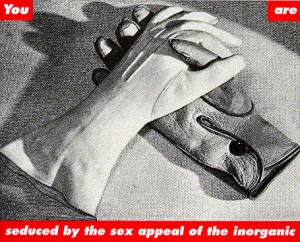
Barbara Kruger, Untitled (You are seduced by the sex appeal of the inorganic), 1987. Silkscreen 1.3×1.3 m
A request from i-D magazine to shoot a Miu Miu skirt is an opportunity to see clothing as a Modernist still life or sculpture. Christmas present packaging by Gareth Pugh is photographed for Fantastic Man magazine with the precisionist flair of the machine aesthetic. An experiment by the design provocateurs Dunne & Raby to harness energy emitted by live rodents leads to images that update the paranoiac lab science of the 1950s. When Evans exhibits such laconically elegant photographs they carry this astute assimilation of the best applied photography of the past. Little surprise then that Evans’s touchstone is Evidence (1977), the gnomic book of photographs gathered by artists Mike Mandel and Larry Sultan from police, scientific and fire department archives. Strip the most functional photography to its bare essentials and you’re left with enigmas, not facts.
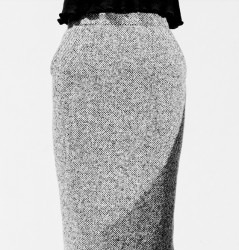
Jason Evans Miu Miu skirt 2005 Photograph for i-D magazine. Styled by Adam Howe
With its use of images and objects from the recent past, there is a twinge of ‘retro’ here, comparable in some respects to the work of photographers – for all their differences – such as Christopher Williams and Roe Ethridge. This is less nostalgia than a sign of how hard it is to develop an artistic relation to the very new. ‘Design just a little dated will interest any artist. Design current is always terrible. Anyone who has tried to find a good contemporary lamp or clock will know what I mean.’4 So declared Walker Evans. How perceptive. He wasn’t writing off the aesthetic of any era, merely noting that not-newness is what often permits artistic access.
Countering the restraint and historical consciousness of his black and white work, Jason Evans’s colour photography is a nower-than- now world of crazed form and crafty process. The hugely popular website thedailynice.com is an outlet for his compulsive photo-notations that have no other home. There’s only ever one image to see, which changes daily, and there is no archive. What you are likely to get is a disarming configuration of colour and shape presented as a considered observation of the made stuff that fills the material world. Fittingly, when thedailynice.com briefly became a gallery exhibition in 2009, visitors could help themselves to prints from a big cardboard box on a table.
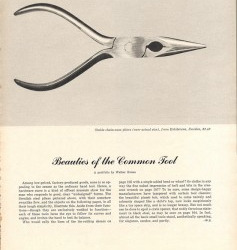
Walker Evans, Page from ‘Beauties of the Common Tool’, Fortune, July 1955
Evans’s artwork for musicians such as Wild Beasts and Four Tet reminds you that record covers can still be hotly anticipated and dearly prized. The sleeve for Four Tet’s There is Love in You (2010) started with the scavenging of test prints made each morning by the digital photo labs of central London. Colour spectrums, bright flowers and fine geometric grids will tell technicians if their printers are working correctly. These were pinned on his studio wall and photographed on colour negative film, which was then subjected to a hole-punch.

Gabriel Orozco, Cats and Watermelons, 1992
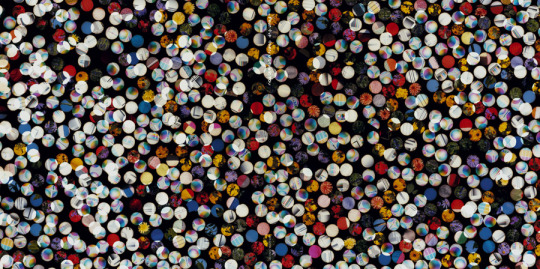
ason Evans, artwork for the Four Tet album There is Love in You, Domino Records 2010
The tiny, rough-edged discs were arranged meticulously on a sheet of glass from which a positive print was made. The digital/analogue blend is a consummate visual expression of the electro-acoustic music. Look closely and see that it could only have been made this way. This is still life as pure process, as profound as the best of the process-driven photography in art, but it’s less po-faced and lot more joyous.
This fluid, exploratory and untormented attitude to image-making has much in common with that earlier era of only vague distinctions between art photography and applied photography. If Evans’s refreshing work is now coming to wider attention it’s because it offers so many paths for photography around the Art Obstacle. Besides, in a climate where we are now provided with media-ready art the way supermarkets provide oven-ready chickens, doesn’t most art photography start to seem more applied than fine?
Karl Marx, Capital: A Critique of Political Economy, vol 1., translated by Ben Fowkes, Vintage, New York, 1977, p. 163
Comte de Lautréamont, Les Chants de Maldoror, Œuvres complètes, Guy Lévis Mano, Paris, 1938, p. 256
Roland Barthes, ‘Rhétorique de l’image’ (Rhetoric of the Image), Communications no. 4, Seuil, Paris, 1964, p. 40–51. Published in English in Barthes’ anthology Image-Music-Text, Fontana, 1977
Walker Evans, ‘Collectors Items’, Mademoiselle, May 1963. Evans’s statement accompanied his photographs of thrift store windows, shot as if they were found still-life compositions. See David Campany, Walker Evans: the magazine work, Steidl, 2014
Link
1 note
·
View note
Video
vimeo
A neighboring pair of tag team wrestlers learn the downsides of life without a landlord. Jury Award Winner - SXSW Film Festival Starring Randy E. Aguebor as Garbageman Bart Mike Dell as Garbageman Chet Lance Hoyt as Crusher Chaz Taylor as Big Shemp Tim Mateer as Mr. Flip Danny Weiner as Kurt Hoppenheimer and Jimmy Hart as Judge Justice Directed by Todd Rohal Written by Bryan Connolly, Zack Carlson & Todd Rohal Produced by - Kelly Williams, Jonathan Duffy, Mark Costa, Walter Newman, Keith Crawford Director of Photography - Ben Kasulke Music & Raps by T.W. Bond Edited by Todd Rohal Casting Director - Vicky Boone Production Designer - Ben Blankenship Art Director - Gevin Booth Art Dept - Jon Darby & Evelyn Weston Costume Designer - Annell Brouder Makeup by Maya Gandhi Mixed by Eric Friend Color and FX by Nick Smith FX and Explosions by Joe Nicolosi Filmed in Austin, TX
0 notes
Video
vimeo
A neighboring pair of tag team wrestlers learn the downsides of life without a landlord. Jury Award Winner - SXSW Film Festival Starring Randy E. Aguebor as Garbageman Bart Mike Dell as Garbageman Chet Lance Hoyt as Crusher Chaz Taylor as Big Shemp Tim Mateer as Mr. Flip Danny Weiner as Kurt Hoppenheimer and Jimmy Hart as Judge Justice Directed by Todd Rohal Written by Bryan Connolly, Zack Carlson & Todd Rohal Produced by - Kelly Williams, Jonathan Duffy, Mark Costa, Walter Newman, Keith Crawford Director of Photography - Ben Kasulke Music & Raps by T.W. Bond Edited by Todd Rohal Casting Director - Vicky Boone Production Designer - Ben Blankenship Art Director - Gevin Booth Art Dept - Jon Darby & Evelyn Weston Costume Designer - Annell Brouder Makeup by Maya Gandhi Mixed by Eric Friend Color and FX by Nick Smith FX and Explosions by Joe Nicolosi Filmed in Austin, TX
0 notes
Text
Getting to know you
I was tagged by @scottxlogan
Rules: tag 20 blogs you’d like to get to know better
Nickname: T.
Zodiac Sign: Aries
Height: 5'6 1/2"
Last thing you googled: Zaxby's Chicken place to see if they had grilled chicken on the menu because my aunt is extremely picky and essentially a child (no, really - she has Alzheimer's, and she is mentally a 5-year-old now with no comprehensible communication skills)
Favorite music artist: The Doors, Jethro Tull, Leonard Cohen, and Loreena McKennitt
Song stuck in my head: Nothing's stuck in my head at the moment.
Last movie you watched: At the theatre - Guardians of the Galaxy 2. At home: Mama.
What are you wearing right now: Gray pj pants, underwear because Jean Grey's here (the bitch), and a navy blue tank top.
Why did you choose your URL: Because Byron once stated that "Truth is strange, stranger than fiction." And that just worked for me.
Do you have any other blogs: I do. Not on Tumblr, but I do. I have a Dreamwidth journal that is friends' only. I have a Twitter account, which is like blog-lite. I have Geek Girl Gourmet, which is my food blog. I have my Tea & Poetry, which is my poetry blog that I need to add more to. I'm currently (slowly) working on a website/blog-lite for tarot/rune reading and dream interpretation so that I can drum up a little online business in order to better support myself financially until I can live in a city where I can find a job. And the Roommate is working on an online photography portfolio blog for me.
What did your last relationship teach you: That as an empath, I need to NOT be involved with a flirtatious, large breast-obsessed, kitchen control nazi with narcissism because it does nothing but lead me onto a road of self-loathing and insecurity.
Favorite color: It changes with my mood. I'm a mood person -- my favorite will literally change with what frame of mind I'm in at the time (or even what I see that I like in that color).
Average hours of sleep: 6-7, depending on whether or not there are plans for the morning.
Lucky number: 9 and anything that equals 9.
Favorite characters: MCU - Loki, Thor, Tony Stark, Steve Rogers, Phil Coulson, Bruce Banner, Stephen Strange, Jarvis. X-Men: Cyclops, Emma Frost, Kurt Wagner, Bobby Drake, Logan, Kitty Pryde, Erik Lensherr, (sometimes) Charles Xavier (at least in the movies, and mostly Patrick Stewart), Hank McCoy. Other fandoms: Hannibal Lecter (esp TV show), Will Graham (esp TV show), Mr. Nancy (Anansi), Mr. Ibis and Mr. Jaquel. Rimble, Barlimo, Doogat, Rowenaster. Wile E. Coyote. Ryan Hardy and Mike Weston (The Following). Oswald Cobblepot and Ed Nygma (Gotham). Holmes and Watson (esp BBC, and RDJ/Jude Law). Neal Oliver and O.W. Grant (Interstate 60). Puck and Oberon and Titania (A Midsummer Night's Dream). Thomas Sharpe and Edith Cushing (Crimson Peak). Bobby Singer, Gabriel, Death, Balthazar (SPN).
How many blankets you sleep with: 4. One sheet, one quilt, and both I kick off half the night because it's so fucking hot in this house.
Dream job: Photographer and food blogger/critic.
I’m tagging: I don't think I know 20 bloggers on here, so I'm just tagging who I tag. If you want to play along, go or it. @kleenexwoman, @majorenglishesquire, @izarnia, @elvenferretots, @jcrewguy, @elekdragon, @hughxjackman, @oceanplait, @oneslave
2 notes
·
View notes
Video
vimeo
A neighboring pair of tag team wrestlers learn the downsides of life without a landlord. Jury Award Winner - SXSW Film Festival Starring Randy E. Aguebor as Garbageman Bart Mike Dell as Garbageman Chet Lance Hoyt as Crusher Chaz Taylor as Big Shemp Tim Mateer as Mr. Flip Danny Weiner as Kurt Hoppenheimer and Jimmy Hart as Judge Justice Directed by Todd Rohal Written by Bryan Connolly, Zack Carlson & Todd Rohal Produced by - Kelly Williams, Jonathan Duffy, Mark Costa, Walter Newman, Keith Crawford Director of Photography - Ben Kasulke Music & Raps by T.W. Bond Edited by Todd Rohal Casting Director - Vicky Boone Production Designer - Ben Blankenship Art Director - Gevin Booth Art Dept - Jon Darby & Evelyn Weston Costume Designer - Annell Brouder Makeup by Maya Gandhi Mixed by Eric Friend Color and FX by Nick Smith FX and Explosions by Joe Nicolosi Filmed in Austin, TX
0 notes
Text
http://lenscratch.com/2023/12/inner-vision-photography-by-blind-artists-kurt-weston/
#photography#lenscratch#photographer interview#Kurt Weston photography#black and white#blind photographers#bnw photography#black and white photography#inner vision#award winning photographer
1 note
·
View note
Text
#photography#photography blog#photographers#photographer interview#kurt weston photography#blackandwhite photography#blind vision series#blind vision photography series#hiv and aids#bnw photography#award winning photographers legally blind photographers#alina oswald writing
1 note
·
View note
Text
#photography#photography blog#photoblog#blackandwhitephotography#photo blog#photographer#kurt weston#award winning photographer#journey through darkness#short film#tribeca films#light#blind photographers#legally blind photographers#kurt weston photography#kurt weston cover story#photographer interview#coverstory interview#writing#blackandwhite#hiv#aids#creative writing#alina oswald writing
1 note
·
View note
Text
#photography#photographers#kurt weston#blind photographers#short film#rising voices#in your light do we see light#vision loss#must see film#must see short film
1 note
·
View note
Text
Kurt Weston: Portraits Through Time
https://outinjersey.net/award-winning-photographer-kurt-weston-on-surviving-two-pandemics/
#kurt weston#award-winning photographer#interview#out in jersey magazine#surviving two pandemics#kurt weston photography#HIV/AIDS#coronaviruspandemic#covid_19#photography portfolio#black and white photography#interview with kurt weston#interview with award-winning photographer kurt weston#photographer interview#portraits#kurt weston portrait photography
2 notes
·
View notes
Link
#Kurt Weston#Kurt Weston photography#award-winning photographer#interview with Kurt Weston#Out IN Jersey Magazine#fashion photography show#John Wayne airport#learning from photographers#photo blog#photography blog#photoblog#Kurt Weston fashion photography#Kurt Weston black-and-white photography#ask a photographer#The Last Light#Journeys Through Darkness#Kurt Weston photographer
1 note
·
View note